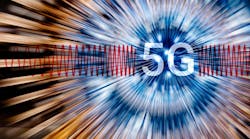You’ve heard plenty about mmWave 5G already, and how it’s going to usher in a utopic future of unbridled hyperfast connectivity. What’s it about and what’s happening with it? I had an opportunity to hear Qualcomm’s perspective on mmWave 5G from Manish Tripathi, VP of engineering, and it’s an exciting one.
mmWave 5G happens at frequencies of 24 GHz and higher, all the way to 100 GHz. That’s a vast swath of spectrum, about 25X the amount used for 3G/4G. And that spectrum is being claimed by operators worldwide. Here in the U.S., commercial deployments are occurring in over 55 cities, mostly in the 28- and 39-GHz bands. Three FCC auctions have allocated 24, 37, and 47 GHz as well.
Whereas 4G took some time for carriers and handset makers to embrace it as mainstream, the industry is taking 5G seriously a lot earlier. If you’re carrying a flagship device from any of the major cellphone makers, such as the iPhone 12, you’re already set for mmWave 5G. The same goes for modules for industrial deployments, Wi-Fi hotspots, and customer premises equipment (CPE).
mmWave 5G is going to bring all sorts of opportunities to both indoor and outdoor deployments. In the U.S., more than 40 stadiums already have their infrastructures in place, ready to provide mmWave service to thousands of users at once. In fact, mmWave 5G was in use at Raymond James Stadium in Tampa, Fla. at this year’s Super Bowl LV. Indoors, mmWave 5G will complement existing Wi-Fi services, bringing superior speeds and virtually unlimited capacity.
In performance field testing of commercial networks, mmWave 5G has demonstrated sustained downlink speeds of 1 Gb/s and higher in all sorts of scenarios. It doesn’t matter if the device is connected to cells near, far, or in between, or if it’s in a moving vehicle. Speed testing conducted with Ookla showed peak download speeds of 3 Gb/s, far better than sub-6-GHz bands or 4G LTE.
Qualcomm did some testing of mobile mmWave in an indoor enterprise use case right in its own facility. The company installed a commercial mmWave 5G site in the lobby, and the experiment has given the lie to the notion that mmWave works only on a line-of-sight basis.
In the rear of the lobby is a free-standing elevator shaft that you can get between yourself and the mmWave site. Even there, Tripathi reports, you can obtain a very usable mmWave 5G signal. That single CPE site provides solid coverage throughout the lobby, in the building’s atrium, and in part of an adjacent auditorium. Some of the coverage is because mmWave signals propagate well reflectively.
mmWave 5G will significantly enhance the mobile user experience in all manner of settings: urban areas, mass transit, smart factories, and even rural regions with extended-range CPE. Enhancements are still in the works, such as optimized coverage and beam management as well as use cases beyond enhanced mobile broadband (eMBB) like industrial IoT, in Release 17+.
Deployment is progressing, although it’s been slowed in some cities by painful permit processes for operators. But once enough sites are up and running, your iPhone 12 or Galaxy S21 is going to become much more fun to use.

